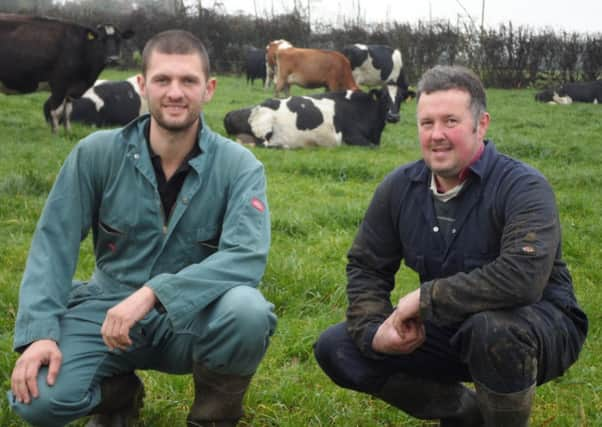Farmer who never has to worry grass is greener on the other side


Grass is one of the livestock world’s most important commodities and for dairy farmers it is critical to get its growth right as herd performance can suffer dramatically.
One man who has done just that and has impressed his peers is Mark Cash, of Fourth Milestone Farm, near York, who was honoured recently by the British Grassland Society when they announced him as runner-up in this year’s Grassland Farmer of the Year competition.
Advertisement
Hide AdAdvertisement
Hide AdNational recognition has come quickly for Mark who only joined up with James Waterhouse just 18 months ago in a joint venture agreement through Evolution Farming after having transformed other dairy farms around the UK. It’s an arrangement that has not only worked for Mark it has also reignited James’ passion for dairy farming.
“I feel very privileged to have found a farmer like Jim. There are not many who can deal with change the way he has with someone new coming in. We’ve completely changed the farming platform in just a year and a half and we’re now moving forward very positively.”
When Mark arrived Fourth Milestone Farm was a dairy and arable farm with James milking 90 pedigree Ayrshires and running an all-year-round calving pattern. Today the 250 acres are all down to grass and the milking herd incorporates 55 pure Ayrshires, 54 pure Jerseys and the rest down to Friesian/Jersey X. Mark also now has his own cows within what will soon be a 300-strong herd.
“What excites me is cows eating grass efficiently and producing a profit. From a financial perspective it is also a business where you see a regular monthly cheque. Grass is the cheapest feed you will ever have and using it properly is all about efficient working. The longer we can keep cows on grass outside the less we have to purchase other commodities. Our cows are still out now into the second week of November.”
Advertisement
Hide AdAdvertisement
Hide AdMark and Jim now paddock graze their cows. That means that after every milking the currently 280-strong dairy herd is taken to a different three-acre paddock where the herd stays until its next milking. It then does not come back to the same paddock for between 21-60 days as the grass recovers and replenishes. Investment has been made in cow tracks around the farm to the parlour and drinking troughs.
“It keeps us very focused on grassland management. Most of Jim’s farm has now been reseeded into grass that is high in sugars and is drought resistant. I measure the density of the grass with a plate meter to check on the dry matter content which we look to be around 2500-3000kg per hectare before putting the cows on to it. I measure the grass weekly throughout the acreage so I know the past week’s growth and I also know how much the cows have eaten.
“Eventually, during this month we will have to bring the herd inside. That happens when the average cover reduces to about 2100 kgs per hectare. We then bring them back out in the spring with their fresh calves and they quickly re-stimulate the grass to grow at a faster rate leading up to April 10 known as Magic Day when growth exceeds demand. This is also when the grass is at its most nutritious.”
With the system Mark and James have put in place they don’t designate which are to be silage fields. Instead, they cut where Mark has monitored that they have a surplus and this year they have cut 80 per cent of the overall acreage.
Advertisement
Hide AdAdvertisement
Hide AdMark studied Land Based Industries and Dairy Herd Management at Reaseheath College and learned about dairy farming systems with a farm in Cheshire before moving to Malvern, Ringwood and then Wrexham before joining James.
“I found out during my teenage years that working with dairy cows was what I loved doing. What we’re planning here isn’t unique by any means. There are a lot of farms following this imprint of cows eating grass for as long as they can as well as other systems we also use. It all makes sense.”
Mark and James also then move on to focusing on areas such as mating through using AI and bulls, and selling stock.
Once a day milking is largely unheard of in Yorkshire but the duo believe their herd, with an average of around 5,800 kgs per year can cope.
Advertisement
Hide AdAdvertisement
Hide Ad“Ideally, we need to put in a new parlour as milking the 280 cows we have through the existing 16/16 parlour takes four hours every time. That’s eight hours a day we are milking at present. We cannot afford a new parlour just yet and that’s one of the reasons why we can see the benefit of milking as many as half the herd once a day.
“There are not just benefits to our time but also the cows themselves. Once a day milking means that many of them will no longer have to walk down the cow tracks as much. This will also lead to less stress. We have already started on those cows that are more around the 4000kg size and it is certainly helping.
“The parlour we are looking at putting in is a New Zealand-style 24/48 herringbone swing over. It’s a very fast parlour and should see us get through milking easily under two hours.”
Transformed in quick time
Mark was born in Stockport from a non-farming family.
When he left school he worked on a friend’s farm where he discovered his passion. Mark and James have transformed Fourth Milestone Farm in a very short space of time.
The pair have an extremely close working relationship as Mark, his wife Gemma and their 10-month-old son live next door to James, his wife Nicola and their two daughters.